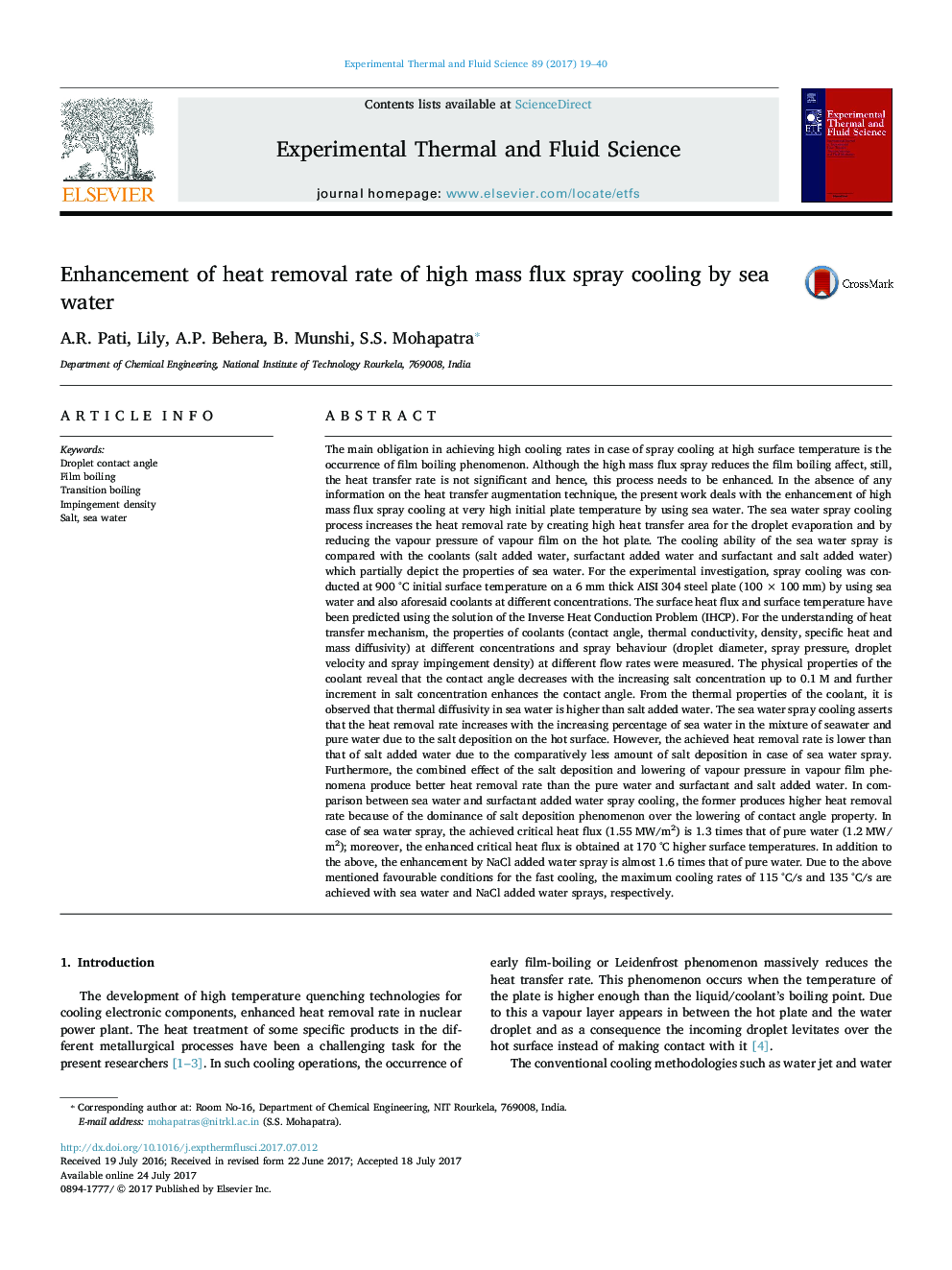| کد مقاله | کد نشریه | سال انتشار | مقاله انگلیسی | نسخه تمام متن |
|---|---|---|---|---|
| 4992452 | 1457387 | 2017 | 22 صفحه PDF | دانلود رایگان |
عنوان انگلیسی مقاله ISI
Enhancement of heat removal rate of high mass flux spray cooling by sea water
ترجمه فارسی عنوان
افزایش میزان حذف گرما از اسپری خنک کننده با جرمی با آب دریا
دانلود مقاله + سفارش ترجمه
دانلود مقاله ISI انگلیسی
رایگان برای ایرانیان
کلمات کلیدی
زاویه تماس قطره جوش فیلم، تغییر جوش، تراکم افت فشار، نمک، آب دریا،
موضوعات مرتبط
مهندسی و علوم پایه
مهندسی شیمی
جریان سیال و فرایندهای انتقال
چکیده انگلیسی
The main obligation in achieving high cooling rates in case of spray cooling at high surface temperature is the occurrence of film boiling phenomenon. Although the high mass flux spray reduces the film boiling affect, still, the heat transfer rate is not significant and hence, this process needs to be enhanced. In the absence of any information on the heat transfer augmentation technique, the present work deals with the enhancement of high mass flux spray cooling at very high initial plate temperature by using sea water. The sea water spray cooling process increases the heat removal rate by creating high heat transfer area for the droplet evaporation and by reducing the vapour pressure of vapour film on the hot plate. The cooling ability of the sea water spray is compared with the coolants (salt added water, surfactant added water and surfactant and salt added water) which partially depict the properties of sea water. For the experimental investigation, spray cooling was conducted at 900 °C initial surface temperature on a 6 mm thick AISI 304 steel plate (100 Ã 100 mm) by using sea water and also aforesaid coolants at different concentrations. The surface heat flux and surface temperature have been predicted using the solution of the Inverse Heat Conduction Problem (IHCP). For the understanding of heat transfer mechanism, the properties of coolants (contact angle, thermal conductivity, density, specific heat and mass diffusivity) at different concentrations and spray behaviour (droplet diameter, spray pressure, droplet velocity and spray impingement density) at different flow rates were measured. The physical properties of the coolant reveal that the contact angle decreases with the increasing salt concentration up to 0.1 M and further increment in salt concentration enhances the contact angle. From the thermal properties of the coolant, it is observed that thermal diffusivity in sea water is higher than salt added water. The sea water spray cooling asserts that the heat removal rate increases with the increasing percentage of sea water in the mixture of seawater and pure water due to the salt deposition on the hot surface. However, the achieved heat removal rate is lower than that of salt added water due to the comparatively less amount of salt deposition in case of sea water spray. Furthermore, the combined effect of the salt deposition and lowering of vapour pressure in vapour film phenomena produce better heat removal rate than the pure water and surfactant and salt added water. In comparison between sea water and surfactant added water spray cooling, the former produces higher heat removal rate because of the dominance of salt deposition phenomenon over the lowering of contact angle property. In case of sea water spray, the achieved critical heat flux (1.55 MW/m2) is 1.3 times that of pure water (1.2 MW/m2); moreover, the enhanced critical heat flux is obtained at 170 °C higher surface temperatures. In addition to the above, the enhancement by NaCl added water spray is almost 1.6 times that of pure water. Due to the above mentioned favourable conditions for the fast cooling, the maximum cooling rates of 115 °C/s and 135 °C/s are achieved with sea water and NaCl added water sprays, respectively.
ناشر
Database: Elsevier - ScienceDirect (ساینس دایرکت)
Journal: Experimental Thermal and Fluid Science - Volume 89, December 2017, Pages 19-40
Journal: Experimental Thermal and Fluid Science - Volume 89, December 2017, Pages 19-40
نویسندگان
A.R. Pati, Lily Lily, A.P. Behera, B. Munshi, S.S. Mohapatra,
